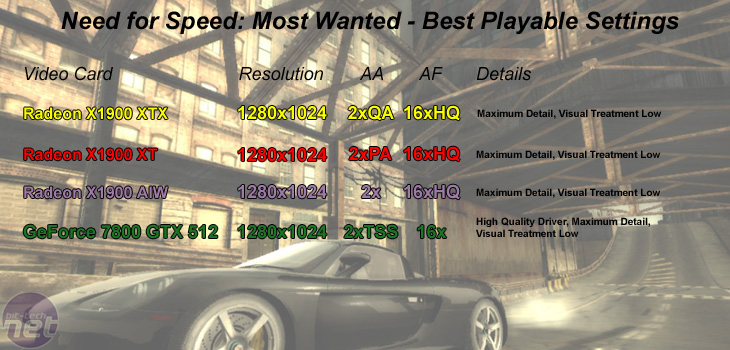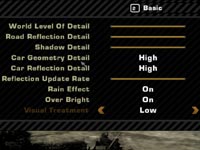
Need For Speed: Most Wanted:
Publisher: Electronic ArtsWe used the full retail version of Need For Speed: Most Wanted patched to version 1.3. It's the latest addition to Electronic Arts' popular Need For Speed franchise. The game makes use of shaders everywhere, with realistic car reflections, a dynamic sky making use of HDR bloom and also weather patterns that change during the game. Most of the game takes place in the daytime, so aliasing is much more noticeable than it was in previous versions of the Need For Speed: Underground sub-franchise - antialiasing is preferred over a higher resolution in order to combat the edge aliasing.
There is a new setting called Visual Treatment which - when set to high - leaves a bright glow on most objects that get in the way of the sunlight. We feel this looks slightly unrealistic as the effect is over-used to an extent and it's best left set to the low setting with overbright enabled. Along with this, there's also the fact that the high setting causes a big performance drop, giving yet another arguement for leaving it on the lower setting.
We did a manual run through of the NFS World Loop sprint track that lasts for around 8 minutes. This is sufficient time to experience the rain effect and normal weather conditions in the same run through. The track gives a good idea of what NFS: Most Wanted will perform like on any card, as it goes around all regions of the world.
We found that the best playable settings in this game were when the average frame rate was above 40 frames per second, while the minimum was above 20 frames per second and the majority of the frames were rendered above 30 fps.


We found that we had to lower the adaptive antialiasing detail from 'quality' to 'performance' in order to attain a smooth gaming experience throughout the race. There was only one part of the track where the performance was a little sloppy - when driving through an area of with lots of trees, smoke and foilage - but the whole experience was a good one and we'd be happy playing the game at these settings.
The GeForce 7800 GTX 512 was as fast as the Radeon X1900XTX and we found that we were able to turn on high quality driver settings to disable all filtering optimisations. This gave us a higher filtering quality, but it wasn't quite enough to match the high quality anisotropic filtering that is possible on the Radeon X1900-series cards. It performed well and we were more than happy with the gaming experience if it was singled out, but wasn't quite as good as the image quality delivered by the X1900XTX.
With the All-In-Wonder X1900, we found that we had to turn off adaptive antialiasing, but we were able to leave high quality anisotropic filtering enabled. We found that the card was capable of very smooth gameplay at 1280x1024 2xAA 16xHQ AF with our maximum optimal image quality settings.

MSI MPG Velox 100R Chassis Review
October 14 2021 | 15:04







Want to comment? Please log in.